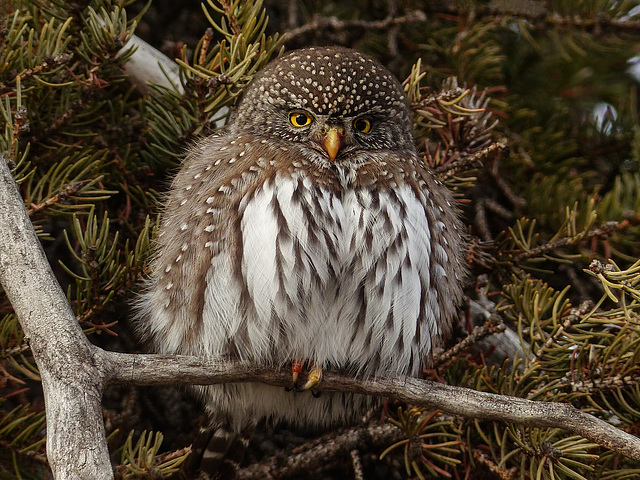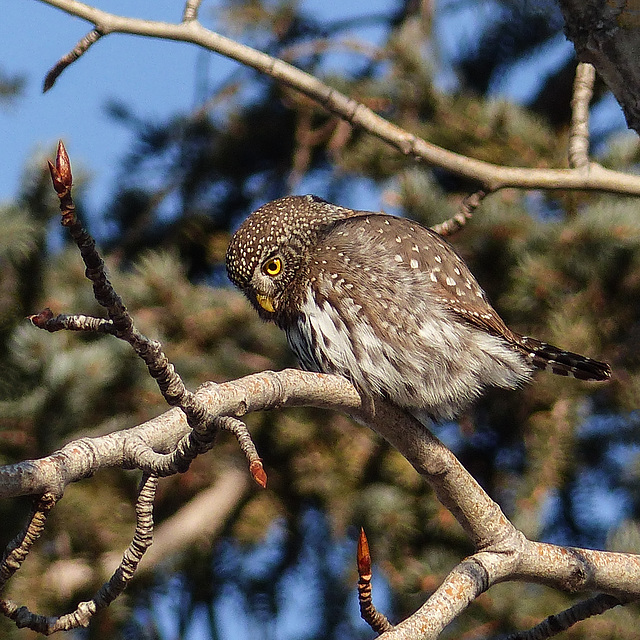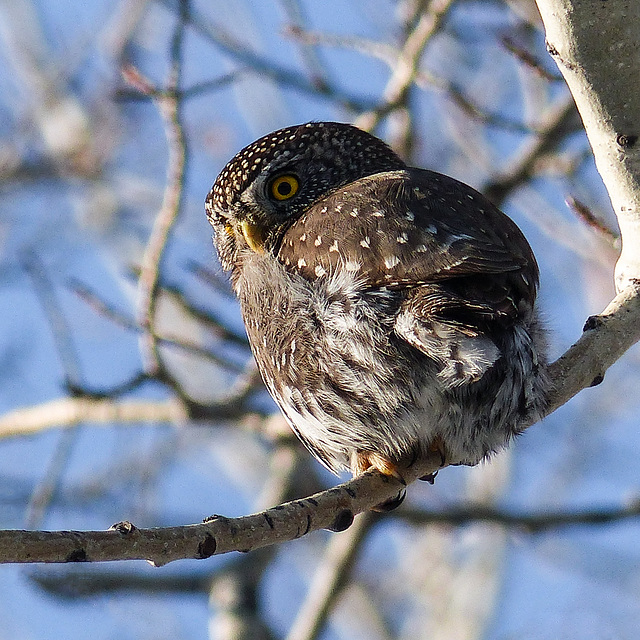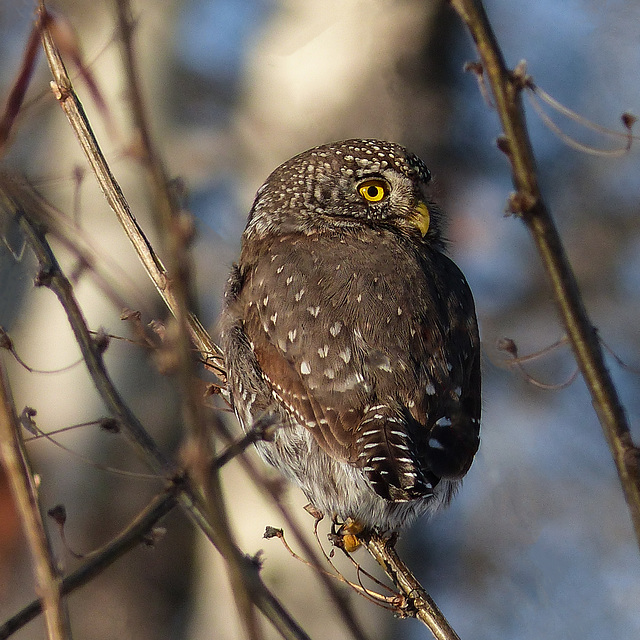
Owls 3
20 Dec 2014
A different pose
Not a good quality image, though it may look all right in small size. I don't usually get photos of Snowy Owls in this position, so thought I would post it. At the time, it looked like this owl was about to fly, but it didn't, instead remaining sitting upright in the more usual pose. Focal Length (35mm format) - 1200 mm, so the owl looks much closer than it actually was.
Back in December, I had been longing to get out there, especially to the E and NE of the city, to look for these spectacular birds of prey. I finally got out, after my youngest daughter asked if I wanted to go looking for Snowies for our Christmas get-together on 20 December 2014. She had never seen a Snowy Owl, so I was really, really hoping that we'd find one! As it turned out, we saw 10 definite individuals, plus two others that we weren't quite sure about - one certainly looked like a very distant Snowy and the other was possibly a repeat of an owl we had seen earlier in more or less the same area.
Part way through the day, almost as if it were meant to happen, a car came from the opposite direction - it was my friends, Cathy and Terry! For the rest of our trip, we followed behind them, thoroughly enjoying every new find. Late afternoon, we went home different ways and my daughter and I saw our last two owls. My daughter was so thrilled to see these breathtaking birds and was quite happy and content after seeing the very first, distant one. Three of the owls gave us close or reasonably close views, the rest were very distant. The owl in this photo is a male, as it is pure white. In contrast, it was one of those days when the sky was amazingly blue.
www.allaboutbirds.org/guide/snowy_owl/lifehistory
en.wikipedia.org/wiki/Snowy_owl
After these wonderful sightings, we returned to Calgary and went back to my daughter's place to exchange Christmas gifts. I reckon the Snowy Owls were the "best" gifts she received that day : )
20 Feb 2015
Tiny, bright-eyed Northern Pygmy-owl
It's now after 1:30 in the morning on 14 March 2015 and I have just finished my work on a couple of photo request projects. My plan is for a day out with a group of friends, IF I wake up in time. Still have to get all my things ready before I can fall into bed. Decided to upload my "daily three" at this unearthly hour instead of just before I leave.
In the afternoon of 20 February 2015, there were just a couple of friends down in the park and, happy to say, they had already found this tiny, popcan-sized owl. This was its perch during the time I was there, giving some nice out in the open views, but all very similar. It's such a beautiful owl. This is the female - the male is smaller, has a more rusty colour especially around the neck, and he has a thicker, white eyebrow line.
"The Northern Pygmy-Owl may be tiny, but it’s a ferocious hunter with a taste for songbirds. These owls are mostly dark brown and white, with long tails, smoothly rounded heads, and piercing yellow eyes. They hunt during the day by sitting quietly and surprising their prey. As a defensive measure, songbirds often gather to mob sitting owls until they fly away. Mobbing songbirds can help you find these unobtrusive owls, as can listening for their call, a high-pitched series of toots." From AllAboutBirds.
www.allaboutbirds.org/guide/Northern_Pygmy-Owl/id
en.wikipedia.org/wiki/Northern_pygmy_owl
03 Feb 2015
1 favorite
1 comment
Northern Pygmy-owl
HAPPY ST. PATRICK'S DAY!
And we are back to winter once again - it snowed the night before last, 15/16 March 2015. Just when practically all the previous build-up of snow and ice had melted.
This photo was taken on 3 February, when I called in at Fish Creek Park for some fresh air and, hopefully, find a friend or two. I was lucky with both - some of the time there were just three of us, watching and photographing this tiny, popcan-sized Northern Pygmy-owl (uncommon in Alberta). It gave us a few good views, including when it flew down to the bushes right in font of us (love it when that happens!). This photo shows how focused the tiny owl is when it's hunting. The EXIF data for this photo gives Focal Length (35mm format) - 1200 mm. There had just been quite a few days that there had been no reports of the owl, so I always felt very fortunate if it appeared when I was there.
"The Northern Pygmy-Owl may be tiny, but it’s a ferocious hunter with a taste for songbirds. These owls are mostly dark brown and white, with long tails, smoothly rounded heads, and piercing yellow eyes. They hunt during the day by sitting quietly and surprising their prey. As a defensive measure, songbirds often gather to mob sitting owls until they fly away. Mobbing songbirds can help you find these unobtrusive owls, as can listening for their call, a high-pitched series of toots." From AllAboutBirds.
www.allaboutbirds.org/guide/Northern_Pygmy-Owl/id
en.wikipedia.org/wiki/Northern_pygmy_owl
22 Feb 2015
1 comment
Looks a long way down from up here
Thought this photo would give an idea of the size difference between a Northern Pygmy-owl and a Meadow Vole. Focal Length (35mm format) - 1200 mm. I will add a photo in a comment box below, taken of the owl on the ground two minutes earlier.
On 22 February 2015, we got this chance to see the tiny, popcan-sized Northern Pygmy-owl in Fish Creek Park. When I arrived, it was perched in a smallish tree, but within a very short time, it suddenly flew down to where we were standing, maybe six feet away from my feet, and then returned to the tree. We were surprised that it sat for so long before eating the brains of its prey and then we began to wonder if perhaps it needed to bring up a pellet first. Sure enough, eventually, that is what it did.
"The Northern Pygmy-Owl may be tiny, but it’s a ferocious hunter with a taste for songbirds. These owls are mostly dark brown and white, with long tails, smoothly rounded heads, and piercing yellow eyes. They hunt during the day by sitting quietly and surprising their prey. As a defensive measure, songbirds often gather to mob sitting owls until they fly away. Mobbing songbirds can help you find these unobtrusive owls, as can listening for their call, a high-pitched series of toots." From AllAboutBirds.
www.allaboutbirds.org/guide/Northern_Pygmy-Owl/id
en.wikipedia.org/wiki/Northern_pygmy_owl
On my way out of the park, an enormous flock of Bohemian Waxwings swarmed around the tall coniferous trees along the edge of the road. Hundreds of them landed at the tops of these trees and then they would swoop down to the snow-covered ground and eat the snow for a few seconds before flying to the other side of the road and back again.
11 Jan 2015
Northern Pygmy-owl
This photo was taken on 11 January 2015 (just 8 days after my oldest daughter passed away), when I called in at Fish Creek Park for some fresh air and, hopefully, find a friend or two. I was lucky with both. It was a Sunday and a lot of photographers had gathered to watch and photograph this tiny, popcan-sized Northern Pygmy-owl. I still have more photos of this little owl that I want to post. Some are better than others - ones like this one I don't post as my main image of the day, but slip it in as the second or third post, which most people don't look at anyway.
I was impressed that all the photographers were very respectful of this tiny owl. Mind you, that day, apart from a couple of very brief, low landings in bushes, the tiny owl stayed perched extremely high in tall trees. Thankfully, it was still within my camera reach and we were all lucky enough to see it perched in a variety of places. Bright blue sky completed the picture.
"The Northern Pygmy-Owl may be tiny, but it’s a ferocious hunter with a taste for songbirds. These owls are mostly dark brown and white, with long tails, smoothly rounded heads, and piercing yellow eyes. They hunt during the day by sitting quietly and surprising their prey. As a defensive measure, songbirds often gather to mob sitting owls until they fly away. Mobbing songbirds can help you find these unobtrusive owls, as can listening for their call, a high-pitched series of toots." From AllAboutBirds.
www.allaboutbirds.org/guide/Northern_Pygmy-Owl/id
en.wikipedia.org/wiki/Northern_pygmy_owl
24 Jan 2015
Northern Pygmy-owl
Saturday, 24 January 2015, was a great day for seeing the tiny, popcan-sized Northern Pygmy-owl in Fish Creek Park. For once, I was up really early so that I could go on a birding walk, which was being held at the same location. Other than the usual Black-capped Chickadee. Nuthatches and Downy Woodpeckers, the two main species that we saw were the Pileated Woodpecker (a male and a female together) and a very distant Cooper's Hawk. When we were at the furthest spot, we got news that the Northern Pygmy-owl had appeared back at our starting point. Needless to say, we were happy to see it that day.
Some time after getting back to where the owl was and seeing it on several different branches that were not particularly easy to photograph, it suddenly flew down to the mass and tangle of bushes right where all the photographers were now standing. A few people knelt or lay down in the cold, melting snow so that they could get a better view through the thin branches. There was no way I could do that, so my view was not as good. As far as actually seeing the owl at such close quarters was concerned, it was a great chance, and was not a case of people getting too close, but that the owl flew to where they were standing. It was amazing to see this tiny bird of prey up close, and it was really good to see how at ease it seemed. No sign of stress at all. It even caught a Meadow Vole and then flew up to a nearby, thin, forked branch, where it posed beautifully along with its catch and then began to eat the Vole's brains.
Soon, it was time to go home, especially as I had originally arrived at the park for the 3-hour bird walk earlier! Some people spend hours in the park and I don't know how they are able to do so. It requires so much patience, and I'd never be able to do it, even for the much shorter time that I'm there, if it weren't for friends to chat with while waiting. Two hours in the park, maybe three, is usually my maximum - and it's definitely not good for the back and knees! Normally, I just don't get down to the park, anyway, especially the last two years or more, but this tiny owl has been an attraction for people from all over the city and from other cities and provinces. Haven't been there other than for one very brief walk, in maybe two and a half or three weeks. I suspect that the owls left some time ago, to go to higher elevations in the mountains.
I also credit this beautiful little owl (and its mate) for helping me get through the weeks after my oldest daughter died. Without this, I would most likely have stayed home all the time, which would not have been good for me at all.
22 Mar 2015
A different Great Horned Owl
On Sunday afternoon, 22 March 2015, I went on a very enjoyable two and a half hour walk at Carburn Park, with birding friends. The weather was good and the company was perfect.
The Great Horned Owl in this photo is, I believe, an owl that was new to me. I don't remember seeing this male, just the female, last year. This one was sitting on guard duty from a tree that was quite a long way from his mate, but he still had a good, clear view of her.
I'll add the list of sightings we had, for my own memory, put together by the leaders of the group:
1. Canada Goose-60
2. American Wigeon-1 m.
3. Mallard-55
4. Bufflehead-60
5. Common Goldeneye-60
6. Common Merganser-7
7. Bald Eagle-2
8. Ring-bill Gull-30
9. Calfornia Gull-30
10.Herring Gull-1
11. Rock Pigeon-3
12. Great Horned Owl-2
13. Downy Woodpecker-8
14. Hairy Woodpecker-1
15. Northern Flicker-5
16. Black-billed Magpie-14
17. American Crow-2
18. Common Raven-8
19. Black-capped Chickadee-5
20. Red-breasted Nuthatch-1
21. White-breasted Nuthatch-1
22. American Robin -4
23. House Finch-3
24. House Sparrow-10+
25. Great Blue Heron
After the walk, four of us went for coffee at Tim Hortons - always as enjoyable as the walk itself, if not more so : )
11 Jan 2015
1 favorite
A backwards glance
I'm still returning to my recent archives to find "new" photos to post of this tiny Northern Pygmy-owl. I think I've posted most of my better shots of him/her, but still have various others that I want to add to my album. I haven't been down to the park for maybe three weeks, and I haven't heard any reports of the owls being seen in that time, or seen any very recent photos, so I suspect the owls have left the park and flown to higher elevations to nest.
This photo was taken on 11 January 2015 (8 days after my oldest daughter passed away), when I called in at Fish Creek Park for some fresh air and, hopefully, find a friend or two for much-needed company. I was lucky with both. It was a Sunday and a lot of photographers had gathered to watch and photograph this tiny, popcan-sized Northern Pygmy-owl. There had been a segment on the TV NEWS about this owl, which brought out a lot of people.
I was impressed that all the photographers were very respectful of this tiny owl. Mind you, that day, apart from a couple of very brief, low landings in bushes (seen in this photo), the tiny owl stayed perched extremely high in very tall trees. Thankfully, it was still within my camera reach and we were all lucky enough to see it perched in a variety of places. Bright blue sky completed the picture that day.
"The Northern Pygmy-Owl may be tiny, but it’s a ferocious hunter with a taste for songbirds. These owls are mostly dark brown and white, with long tails, smoothly rounded heads, and piercing yellow eyes. They hunt during the day by sitting quietly and surprising their prey. As a defensive measure, songbirds often gather to mob sitting owls until they fly away. Mobbing songbirds can help you find these unobtrusive owls, as can listening for their call, a high-pitched series of toots." From AllAboutBirds.
www.allaboutbirds.org/guide/Northern_Pygmy-Owl/id
en.wikipedia.org/wiki/Northern_pygmy_owl
24 Feb 2015
Popcan-sized cutie
Note added on 15 April 2015 - I have been having a real problem with posting photos to ipernity from Flickr the last week. Every once in a while, a photo will post on the first try, but the rest of the time, I have to make several tries before it is successful, or the photo just won't work. Really annoying, and I have no idea why this is happening.
This photo was taken on 24 February 2015, when I called in at Fish Creek Park to see if anyone had been able to find the tiny, popcan-sized Northern Pygmy-owl(s). I was in luck and, although the light was bad, the little owls put on quite a performance. This included a few things that I had missed on other days, such as an owl perched on a fence post, and both owls very briefly sitting on a branch for just a few seconds, side by side. Unfortunately, I was standing the "wrong" side of the tree, so only saw them from behind. Luckily, the female did turn her head for just a moment. There is quite an obvious difference in colour with this pair, with the male being a more rusty colour, and he's smaller than the female. There were long periods of waiting in between the various bits of activity, so one needs a huge amount of patience : )
"Northern Pygmy Owls are 'sit and wait' predators, that hunt mainly by vision, diving down onto prey on the ground and driving the talons into the prey's throat. They will also attack birds in shrubs, crashing into the hapless victims. Most prey is carried off in the feet to feeding sites. Birds are usually plucked before being consumed. They often eat only the brains of birds and the soft abdomen of insects. One of these little owls can carry prey weighing up to 3 times its own weight.
The Northern Pygmy Owl feeds on a wide range of small prey including small mammals, birds, and reptiles and amphibians. Voles make up the bulk of their diet, with birds comprising most of the rest (mainly songbirds, but as large as a California Quail). Other small mammals include shrews, mice, chipmunks, bats, moles, young rabbits, and weasels. Insects may be very important when they are most abundant. Other prey taken are toads, frogs and small lizards and snakes.
During winter, surplus prey is cached in a cavity, often in large quantities. Summer caches are usually much smaller.
Pellets are very small, averaging about 3cm long. They are formed only occasionally as these owls don't consume large amounts of fur, feathers, or bone. The pellets tend to fall apart shortly after ejection." From OwlPages.
www.owlpages.com/owls.php?genus=Glaucidium&species=ca...
Jump to top
RSS feed- Latest items - Subscribe to the latest items added to this album
- ipernity © 2007-2024
- Help & Contact
|
Club news
|
About ipernity
|
History |
ipernity Club & Prices |
Guide of good conduct
Donate | Group guidelines | Privacy policy | Terms of use | Statutes | In memoria -
Facebook
Twitter










